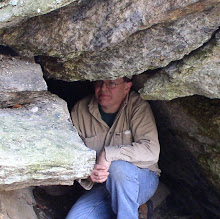I missed out attending the big Worcester County postcard show back in March due to unfavorable weather. But, I thought I'd take in a smaller show in Greenfield this past weekend. It also afforded me the chance to connect with Quabbin expert J. R. Greene.
After the show, I returned to my 'rocky friends' further south in the Connecticut Valley. A mysterious old image from a glass slide has surfaced with a theory it may be in Western Massachusetts. To me, it looked to be something very similar to what exists in the Mt. Toby region. So, I looked over two sets of ledges there.
The first ledge is home to the marvelous Sunderland Cave, whose written record goes back to the early 1800's. The second set of ledges was once know as Graves Ledge, as it was the boundary to Mary Jane Graves' property.
In the end, I was unable to positively identify the site of the old glass slide. But I did make use of the time to photograph a few of the sites previously done by John Lovell almost 150 years earlier.



